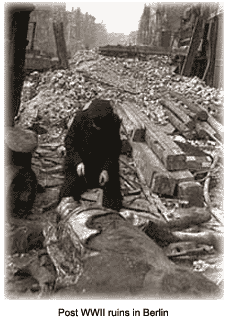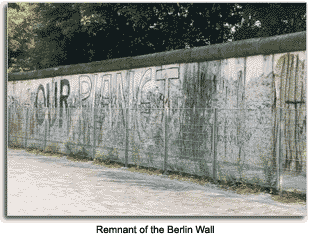Introduction
When World War II in Europe ended in May 1945, the continent lay in ruins. Once-fertile fields were scarred by bomb craters and tank tracks. In cities, seas of rubble — an estimated 500 million cubic tons of it in Germany alone — surrounded abandoned, gutted buildings. With factories and businesses destroyed, many people were unemployed. Food was so scarce that millions existed on the verge of starvation. Life in Europe, especially Germany, was dismal at best.
As the Marshall Plan became established, communist opposition grew. Criticism was especially strong in November 1949, after Paul Hoffman, head of the Economic Cooperation Administration (ECA), spoke to the Council of the European Economic Cooperation Association. Addressing the representatives of the countries involved in the Marshall Plan, Hoffman suggested creating a united western European market based on elimination of customs barriers and tariffs.
By promoting European economic integration, the ECA laid the foundation for the founding of the European Economic Community in the 1950s and for today's democratic European Union. The French newspaper L'Humanité reacted like many other communist publications, claiming that, "After disorganizing the national economies of the countries which are under the American yoke, American leaders now intend conclusively to subjugate the economy of these countries to their own interests."
Occupation and partitioning
Under a common occupation policy developed principally in conferences at Yalta and Potsdam in 1945, the Allied powers assumed joint sovereign authority over Germany. American, British, Soviet, and French forces occupied separate zones, and national matters came before an Allied Control Council comprising the commanders of the four occupation armies. Berlin, lying deep in the Soviet zone in eastern Germany, was similarly divided and governed. That is, the city of Berlin, surrounded by the Soviet Zone, was partitioned into four zones. The zones occupied by the Allies lay on the west side of the city, and east Berlin was occupied by the Soviets. West Germany and West Berlin received massive injections of U.S. capital, which attracted many workers from miserable economic conditions in the East.
 In the American zone, Army occupation troops proceeded rapidly with disarmament, demilitarization, and eradication of Nazi influence from German life. Meanwhile, American officials participated as members of an International Military Tribunal, known as the Nuremberg Trials, which tried 22 major leaders of the Nazi party, sentencing 12 to death, imprisoning seven, and acquitting three. An Office of Military Government supervised German civil affairs within the American zone, working increasingly through German local, state, and zonal agencies with politically reliable staffs. A special U.S. Constabulary, organized by the Army as demobilization reduced the strength of armed units in Germany, operated as a mobile police force.
In the American zone, Army occupation troops proceeded rapidly with disarmament, demilitarization, and eradication of Nazi influence from German life. Meanwhile, American officials participated as members of an International Military Tribunal, known as the Nuremberg Trials, which tried 22 major leaders of the Nazi party, sentencing 12 to death, imprisoning seven, and acquitting three. An Office of Military Government supervised German civil affairs within the American zone, working increasingly through German local, state, and zonal agencies with politically reliable staffs. A special U.S. Constabulary, organized by the Army as demobilization reduced the strength of armed units in Germany, operated as a mobile police force.
Each of the other occupying powers organized its zone along similar lines. However, the Allied Control Council, which could act only by unanimous agreement, failed to achieve unanimity on such nationwide matters as central economic administrative agencies, political parties, labor organizations, foreign and internal trade, currency, and land reform. U.S.S.R. demands and dissents were chiefly responsible for the failures. Each zone inevitably became a self-contained administrative and economic unit, and some two years after the German surrender, little progress had been made toward reconstruction of German national life. The eventual result, first taking shape in September 1949, was a divided Germany: the Federal Republic of Germany in the American, British, and French zones, plus West Berlin; and a communist government in the Soviet zone of East Germany and East Berlin.
The rise of a new opponent
The Berlin Airlift from 1948 to 1949 was the stirring response to a bitter example of Soviet geopolitical exploitation. As demonstrated in Germany, in Korea, and in other areas, the Soviets' grasping foreign policy dashed American hopes for Great Power unity. The U.S.S.R., Winston Churchill warned in a 1946 speech at Fulton, Missouri, was lowering an "iron curtain" across the European continent. The Soviets quickly and successfully drew eastern Germany (and East Berlin), Poland, Hungary, Romania, Bulgaria, Yugoslavia, and Albania behind that curtain. The American response was a foreign policy of "containment", as defined in the Truman Doctrine, of blocking any extension of communist influence. Out of the Truman Doctrine came the Marshall Plan and NATO. The Cold War era had begun.
The partition of West and East Germany was established on May 23, 1949. The leader of West Germany was Konrad Adenauer. He was a non-Nazi patriot who attempted to reunite his country. Adenauer was unsuccessful and, beginning in 1949, the sides were occupied by military forces of the U.S., Britain, and France in West Germany, and the Soviet Army in the East German Zone. With the support of the Western Allies, the west German government, with German officials in place, assumed more authority. The Allies arranged for a general assembly to write a federal constitution. The three zones were combined into the Federal Republic of Germany, and West Germany began to prosper.
The Berlin Wall
By June 1961, efforts to find a resolution to the German question continued, but a solution remained elusive. President Kennedy met with Nikita Khrushchev in Vienna, but the positions of the two leaders, particularly on Berlin, prove irreconcilable. A few days later, Khrushchev announced that he would conclude a separate peace treaty with East Germany that would end the West's right of access to Berlin. The following month, he abandoned a projected reduction in Soviet armed forces, and announced a substantial increase in the defense budget. President Kennedy responded by calling for a build-up of NATO forces.
The Soviet Union threatened to call up reserves. The deepening crisis resulted in large numbers of East Germans fleeing to the West. In the first six months of 1961, the number rose to more than 103,000 mostly young and skilled workers.
 During the night of August 13, the East Germans barricaded the Soviet sector of Berlin and began to build the Berlin Wall. The wall would divide Germany until it was torn down in 1989.
During the Ronald Reagan presidency the fall of the Berlin Wall, which separated West Berlin from East Berlin, officially brought the two sides back together in 1990. The event also marked the beginning of the demise of the Soviet Union and the beginning of the end of the Cold War.
Reunification
During the night of August 13, the East Germans barricaded the Soviet sector of Berlin and began to build the Berlin Wall. The wall would divide Germany until it was torn down in 1989.
During the Ronald Reagan presidency the fall of the Berlin Wall, which separated West Berlin from East Berlin, officially brought the two sides back together in 1990. The event also marked the beginning of the demise of the Soviet Union and the beginning of the end of the Cold War.
Reunification
In June 1990, NATO foreign ministers met in Scotland and took the exceptional step of issuing a “Message from Turnberry," which extended an offer of friendship and cooperation to the Soviet Union and all eastern European countries. The announcement made by President Gorbachev in July 1990, accepting the participation of the united Germany in NATO, was explicitly linked to the positive nature of the Turnberry message, and to the substantive proposals and commitments made by alliance governments in London.
The Helmut Kohl era was recorded as one of the most extraordinary and successful periods in Germany's long history. After 16 years it came to an end when a coalition of Social Democrats and Greens took office in 1998. After the new government took office in 2000, an investigation disclosed that Kohl and his conservative Christian Democratic Union party had operated a slush-fund in defiance of the German constitution.
Germany has absorbed the majority of refugees from the former Yugoslavia. Those and other immigrants are targets of racist attacks. The extreme right wing, cagey and sporadically violent, is politically weak. The united Germany has its problems, but the social dislocation that was widely forecast has proven to be minimal. Although the elation of reunification has subsided, and there is still some animosity from both sides, Germany is working towards true unity.